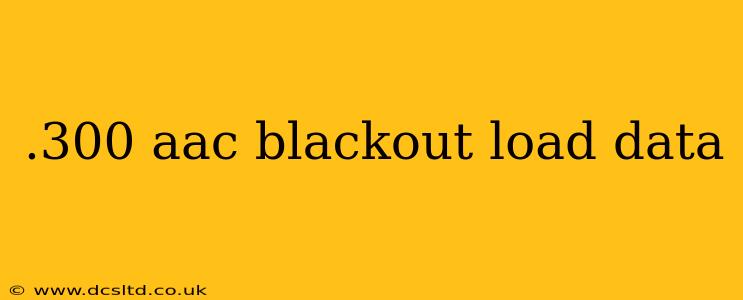The .300 AAC Blackout (also known as .300 BLK) has gained immense popularity among both civilian shooters and military personnel due to its versatility and effectiveness in various applications. Its relatively compact size makes it ideal for short-barreled rifles (SBRs) and pistols, while its potent stopping power proves useful for hunting smaller game and home defense. For reloaders, the .300 BLK offers a rewarding challenge, allowing for precise customization of ammunition to suit individual needs and preferences. However, safety and accuracy are paramount, making a thorough understanding of load data essential. This guide will delve into the critical aspects of .300 AAC Blackout load data, addressing common questions and offering valuable insights.
What are the Best Powders for .300 Blackout?
Choosing the right powder is crucial for achieving optimal performance and safety in .300 BLK reloading. Several powders have proven effective, each with its own characteristics and suitability for different bullet weights and applications:
- Accurate Arms AR-Comp: A popular choice known for its consistent burning rate and clean burning characteristics. It works well across a range of bullet weights.
- Hodgdon CFE BLK: Specifically designed for the .300 BLK cartridge, this powder is praised for its low flash and reduced recoil.
- IMR 8208 XBR: A versatile powder often used in both subsonic and supersonic loads, offering good accuracy and performance.
- Alliant Power Pro 2000-MR: Another excellent option that delivers consistent results and works well across different bullet weights.
Remember that the optimal powder for your setup will depend on your specific bullet weight, desired velocity, and rifle characteristics. Always consult a reputable load data source like the manufacturer's website for specific recommendations.
What Bullet Weights are Commonly Used in .300 Blackout?
The .300 BLK cartridge is versatile in terms of bullet weight, with options ranging from subsonic to supersonic loads:
- Subsonic (under 1100 fps): Bullet weights typically fall within the 208-grain to 220-grain range. These are favored for suppressed applications where reduced noise is a priority.
- Supersonic (over 1100 fps): Bullet weights in the 125-grain to 168-grain range are commonly used for applications requiring longer range and greater penetration.
What is the Best Load Data for .300 Blackout Subsonic Loads?
Developing safe and effective subsonic loads requires careful attention to detail. Subsonic loads generally use heavier bullets and slower burning powders to achieve optimal performance while staying below the speed of sound. Again, always consult manufacturer load data manuals for specific recommendations, as loading data can vary based on the components used. Remember to start at the minimum charge weight listed and work your way up gradually, always monitoring pressure signs.
What is the Best Load Data for .300 Blackout Supersonic Loads?
Supersonic loads generally prioritize velocity and penetration, using lighter bullets and faster burning powders. These loads are suitable for hunting or longer-range shooting. Once again, consulting manufacturer load data is vital, ensuring you remain within safe pressure limits. Pay close attention to your equipment—proper equipment is a critical component of safety.
What are the Safety Precautions When Reloading .300 Blackout?
Reloading ammunition can be dangerous if not done correctly. Observe these essential safety precautions:
- Always wear safety glasses and hearing protection.
- Consult loading manuals from reputable manufacturers for specific load data. Never guess or extrapolate data.
- Start at the minimum charge weight and work your way up gradually.
- Carefully inspect each case for damage before reloading.
- Use a scale to accurately measure powder charges.
- Never mix and match components from different manufacturers without consulting the relevant load data.
- Store ammunition in a safe and secure location.
Where Can I Find Reliable .300 Blackout Load Data?
Reliable load data is critical for safe and effective reloading. Several reputable sources offer comprehensive data:
- Manufacturer's websites: Check the websites of powder manufacturers (Hodgdon, Alliant, Accurate Arms, etc.) and bullet manufacturers for load data specific to their products.
- Reloading manuals: Many comprehensive reloading manuals are available, providing detailed load data for various cartridges, including the .300 BLK.
This information is for educational purposes only. Always prioritize safety when handling firearms and reloading ammunition. Consult multiple sources of load data before beginning any reloading project and always double-check your work. Improper reloading practices can lead to serious injury or death.
